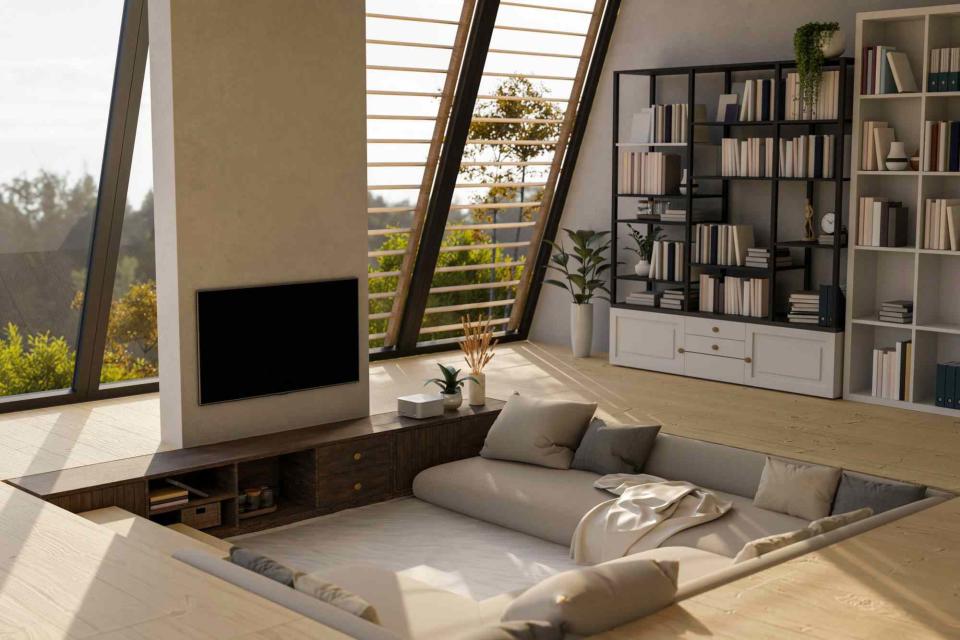Sunken Living Rooms Are Back From the '70s—Here's How to Make Your Own Conversation Pit (Without Renovating Your Home)
You can replicate this trending design feature's nostalgia and coziness on level ground.

To say that the 1970s are enjoying a resurgence would be an understatement. From curved furniture to wood paneling and earthy color palettes, homeowners are wholeheartedly embracing the grooviest decade's design details. Also on that list? Sunken living rooms. Commonly referred to as conversation pits, these recessed gathering areas offer a sense of heightened, cozy intimacy while still lending an open, airy feel.
Ahead, we explore why conversation pits have made such a notable comeback. We also offer some interior designer-approved tips for creating your own version—even if you don't actually have a recessed space in your home.
Related: 6 Furniture Trends That Will Make You Want to Redecorate This Year
Sunken Living Rooms: A Comeback Story
While sunken living rooms actually date back to the 1920s, they officially became mainstream in the '50s—and then made a huge splash in the postmodern '70s, says Chris Jovanelly, the lead interior designer at Est Est Interior Design. As with most trends, sunken living rooms eventually faded out of favor; they became obsolete in new-build floor plans, which covered up or renovated away sunken rooms. Fast forward to now, and the pendulum has swung back in the other direction.
There are a handful of guesses as to why. "Baby boomers grew up with sunken living rooms during the '70s, making them nostalgic—and they have now started incorporating them in the designs of their homes," Jovanelly says. Of course, even people who didn't grow up in that era can appreciate the nostalgia these spaces elicit.
The pandemic's aftermath has also contributed to the conversation pit's comeback, explains Brook Lang, principal designer and owner of Brooke Lang Design. After months of isolation and a devastating lack of connection, the resurgence of intimate spaces that facilitate conversation just makes sense. "Many of us are moving into the post-pandemic era and craving the nostalgia of 'easier times,'" says Lang. "We want to design a common room that promotes connection with friends and family, and these types of dens do just that."
How to Make Your Own Conversation Pit
With the decline in popularity of sunken living rooms, the majority of houses built after 1980 don't have them. That said, unless you live in a home that already has one—or you were lucky enough to discover a hidden recessed space while renovating—building one out is tricky.
As an alternative, homeowners are creating ground-level conversation pits that give the feel of a sunken space without the big-budget remodel. Here are some tips and tricks to create a cozy space that rivals those groovy pits.
Add a Large, Medium-Pile Area Rug
An area rug creates a sense of separation that sunken rooms inherently possess. "A large rug that is 6 inches wider than your sofa on each side is an ideal method to create a focal point in the room and can help create a boundary for the space," says Lang. You could really lean into the theme and go with something retro—like a shag—but otherwise, stick to a medium pile height for a cozy feel, says Lang.
Buy a Low-Set Sectional
The right sectional can really help you fake a sunken effect. Choose a large, low-set, and cozy sectional, which will serve as the centerpiece of the room, adds Lang. The goal is to maximize conversation, so choose pieces that are conducive to this and arrange them strategically.
How you position your couch matters, too. "Closing off the furniture and creating only two access points to the seating group, rather than eight, can create the feel of a conversation pit," says Jovanelly. Complement the sectional with a low-set accent chair or poufs for additional seating. This helps balance the space, so everyone isn't sitting on just one piece of furniture.
Incorporate Pillows and Throws
Create a cozy atmosphere and infuse interesting contrast and texture via pillows and throws, says Nina Magon, the founder and principal of Nina Magon Studio. Iterations with faux fur or tassels deliver on texture, while brightly-colored or patterned pillows bring contrast.
Add a Central Accent Piece
Sunken rooms traditionally feature a central fixture that serves as an anchor—something that naturally draws people together. Fireplaces were a common example, but a large coffee table works too, says Lang. "Look for an oval or circular table to give your room more flow," she says.
Use Warm, Intimate Lighting
Lighting is crucial for any space. To replicate the inviting vibe of a conversation pit, add low-hanging fixtures that provide soft, warm light. You can also add a few standing or table lamps. Aim for natural light during the day and a soft glow in the evening.
Opt for Bold, Retro Art
For yet another nod to the '70s, incorporate decorative design details from the era. "Bold art, such as a mid-century modern painting, and accessories, like vases and sculptural art objects, go a long way in adding extra personality to your space," says Lang (so don't be afraid to get eclectic!).

